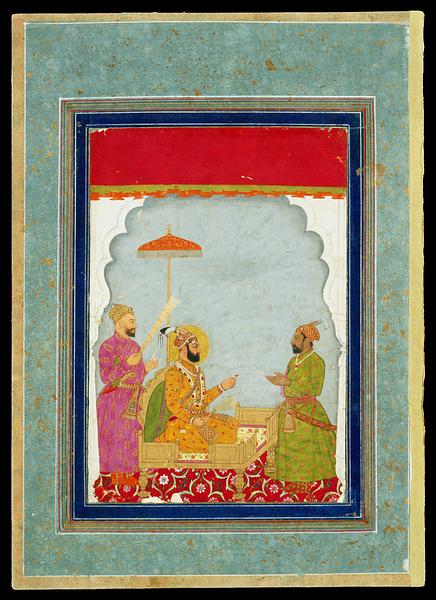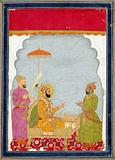Miniature pasted on an album leaf. ‘The Great Mughal Farrukh-siyar Bestows a Jewel’
India, Mughal; between 1713 and 1719
Leaf: 40.1 × 28.6 cm
The last important Mughal emperor, Aurangzeb, died in 1707. An effort was made to maintain the old magnificence of the court in Delhi, but the realm was steadily weakened. It is a twist of fate that Farrukh-siyar (1713-1719) managed to undermine the dynasty’s position of power even further by giving the East India Company concessions in Calcutta before he himself was murdered.
The ruler is enthroned, a courtier standing behind him and an audience-seeker in front of him. He is bedecked with jewels and is in the process of bestowing a bracelet. There were no medals or orders in the Islamic
Inv. no. 26/1982
Published in:
Sotheby’s, London, 3/4-1978, lot 96;
Daniel Ehnbom [et al.]: Two thousand years of Indian art, Spink, London 1982, cat.no. 95;
Kjeld von Folsach, Torben Lundbæk and Peder Mortensen (eds.): Sultan, Shah and Great Mughal: the history and culture of the Islamic world, The National Museum, Copenhagen 1996, cat.no. 342;
Kjeld von Folsach: Art from the World of Islam in The David Collection, Copenhagen 2001, cat.no. 73;
Kjeld von Folsach: For the Privileged Few: Islamic Miniature Painting from The David Collection, Louisiana, Humlebæk 2007, cat.no. 109;
Terence McInerney: “Chitarman II (Kalyan Das)” in Milo C. Beach, Eberhard Fischer, B. N. Goswamy (eds.): Masters of Indian painting, vol. 2, 1650-1900, Zûrich 2011, cat.no. 10, fig. 5;
Kjeld von Folsach: Flora islamica: plantemotiver i islamisk kunst, Davids Samling, København 2013, cat.no. 62;
Susan Stronge, Joanna Whalley and Anna Ferrari: Bejewelled treasures: the Al Thani Collection, Victoria and Albert Museum, London 2015, fig. 3, p. 12;
Kjeld von Folsach, Joachim Meyer and Peter Wandel: Fighting, Hunting, Impressing. Arms and Armour from the Islamic World 1500-1850, The David Collection, Copenhagen 2021, cat.no. 121;


